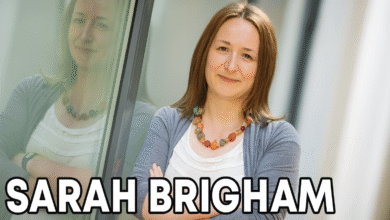Helen Sharman – Britain’s First Astronaut and Trailblazing Chemist Who Reached the Stars

Introduction
Helen Sharman remains one of Britain’s most inspiring scientific figures — a woman whose intelligence, determination, and courage helped her break barriers in both chemistry and space exploration. Known as the first British person in space, Helen Sharman transformed from an industrial chemist into a celebrated astronaut, setting an example of how curiosity and perseverance can lead to extraordinary achievements. Her journey from Sheffield to the Mir Space Station in 1991 stands as a historic milestone, symbolizing both national pride and global collaboration.
Early Life and Education
Born on 30 May 1963 in Grenoside, Sheffield, England, Helen Sharman showed a fascination for science from a young age. She was an inquisitive student who loved to understand how things worked, a quality that later defined her career. After completing her early education in Sheffield, she pursued a Bachelor’s degree in Chemistry from the University of Sheffield, graduating in 1984. Her academic journey didn’t stop there; she went on to earn a PhD in Chemistry from Birkbeck, University of London, in 1987.
Her upbringing in a supportive and hardworking family fostered her independence and discipline. These traits would later serve her well during her astronaut training and space mission.
The Start of a Promising Career
Before entering the world of space exploration, Helen Sharman built a successful career as a chemist. Her first role was with GEC (General Electric Company) in London, where she worked on analytical and technical chemistry research projects. Later, she joined Mars Confectionery Ltd., where she studied the chemical composition of chocolate and flavor compounds. This fascinating work earned her the nickname “The Girl from Mars”, which became a humorous foreshadowing of her future journey beyond Earth.
Her meticulous research, precision, and problem-solving skills in the lab prepared her for the challenges of astronaut training — even though she didn’t yet know her life was about to change in an extraordinary way.
The Path to Becoming an Astronaut
In 1989, while driving home from work, Helen Sharman heard a radio advertisement that would forever change her destiny. The announcement called for applicants to become the first British astronaut, with the simple yet captivating message:
“Astronaut wanted. No experience necessary.”
This was part of Project Juno, a British–Soviet space program aimed at sending the first Briton into space. Among 13,000 applicants, Helen Sharman stood out for her intelligence, physical fitness, and adaptability. Her strong background in chemistry and fluency in languages also gave her an edge. After enduring a series of rigorous tests — both psychological and physical — she was chosen for the mission.
She then spent 18 months training at Star City near Moscow, the Soviet Union’s prestigious cosmonaut training center. During this time, she learned Russian, studied spacecraft systems, participated in weightlessness simulations, and prepared for life in space. Her determination, resilience, and professionalism earned her the respect of her Soviet peers.
The Historic Spaceflight – Soyuz TM-12
On 18 May 1991, Helen Sharman made history when she launched aboard Soyuz TM-12 alongside Soviet cosmonauts Anatoly Artsebarsky and Sergei Krikalev. Their destination was the Mir Space Station, one of humanity’s most advanced orbital laboratories at the time.
During her eight-day mission, she carried out scientific experiments in chemistry, biology, and physics. She studied plant growth in microgravity, performed materials research, and even communicated with schoolchildren in the UK via radio — inspiring thousands of young minds back home. Her mission not only demonstrated the value of international cooperation in science but also highlighted the power of education and curiosity to unite people across borders.
At just 27 years old, Helen Sharman became:
-
The first British person in space
-
The first Western European woman in space
-
The first woman to visit the Mir Space Station
Her success showed the world that space exploration was not limited by gender or nationality — only by the limits of imagination.
Life and Career After Space
Following her return to Earth, Helen Sharman became an instant national hero and a symbol of scientific excellence. She used her newfound fame to promote STEM education (Science, Technology, Engineering, and Mathematics) and to inspire young people, especially girls, to pursue careers in science and space exploration.
In 1993, she published her autobiography, Seize the Moment, detailing her extraordinary journey. She also wrote a children’s book titled The Space Place, encouraging curiosity and imagination among young readers. As a public speaker and science communicator, Helen Sharman has continued to motivate audiences across the world through lectures, interviews, and educational programs.
Professionally, she took on several influential roles, including:
-
Group Leader, Surface and Nanoanalysis Group at the National Physical Laboratory (NPL)
-
Operations Manager, Department of Chemistry at Imperial College London
Through these positions, she has contributed to both scientific research and education, continuing to advance her lifelong mission of promoting scientific understanding.
Awards and Achievements
Over the years, Helen Sharman has received numerous national and international honors for her achievements:
-
OBE (Officer of the Order of the British Empire) – 1992
-
CMG (Companion of the Order of St. Michael and St. George) – 2018
-
Order of Friendship of Peoples (USSR) – 1991
-
Medal for Merit in Space Exploration (Russia) – 2011
-
Honorary Fellow of the Royal Society of Chemistry (HonFRSC)
She has also received multiple honorary doctorates from universities across the UK. Several schools and streets have been named in her honor, including Helen Sharman Drive and Helen Sharman School, celebrating her contribution to science and education.
Legacy and Inspiration
The influence of Helen Sharman extends far beyond her time in orbit. She remains an enduring symbol of determination, equality, and exploration. Her journey has inspired generations of scientists, engineers, and dreamers, showing that ordinary individuals can accomplish extraordinary things when driven by curiosity and courage.
Moreover, her mission represented a bridge between nations during a time of political change. By flying with the Soviet space program, she helped promote peaceful cooperation in science — a message that continues to resonate in today’s world. Helen Sharman proves that boundaries, whether national or personal, can be transcended through the power of human ambition and learning.
Conclusion
From her early days as a chemist in Sheffield to her groundbreaking journey aboard Soyuz TM-12, Helen Sharman’s life reflects resilience, intellect, and inspiration. She remains a living testament to the limitless potential of human curiosity. Her story continues to remind us that dreams, when combined with knowledge and courage, can take us far beyond our imagination — even to the stars.
Frequently Asked Questions (FAQ)
Q1: Who is Helen Sharman?
Helen Sharman is a British chemist and astronaut, best known as the first British person in space, who flew aboard the Soviet spacecraft Soyuz TM-12 in 1991.
Q2: What did Helen Sharman do before becoming an astronaut?
Before joining the space program, Helen Sharman worked as a research chemist at GEC and later at Mars Confectionery, where she studied the chemistry of chocolate.
Q3: When did Helen Sharman go to space?
Helen Sharman launched into space on 18 May 1991 and spent nearly eight days aboard the Mir Space Station.
Q4: What awards has Helen Sharman received?
She has been honored with the OBE, CMG, Order of Friendship of Peoples, and the Medal for Merit in Space Exploration, among many others.
Q5: What is Helen Sharman doing now?
Helen Sharman currently works at Imperial College London as the Operations Manager in the Department of Chemistry and continues to promote science education and public engagement.
Read also: Amelie McCann: The Inspiring Journey of Madeleine McCann’s Twin Sister



